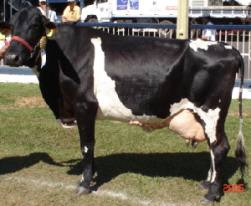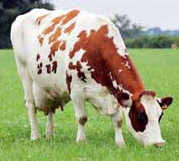



Girolando
History
The origins of the first Girolando date from the 1940's, compared to other breeds it is a relatively young breed. Photo courtesy of Fazenda Morro Da Mandioca, www.morrodamandioca.com.br |
Production and popularity of this breed as been sped up due to its high productivity in terms of fertility and efficiency plus, the efforts of the governmental project for improvement called 'Program Girolando'.
In 1989 the Ministry of Agriculture together with the representing associations, drafted the standards for the breeding of Girolando to be 5/8 Holtein and 3/8 Gir.
Today the Girolando is responsible for 80% of milk produced in Brazil.
Characteristics
The Girolando takes its looks from the Holstein and the Gir, it can be black and white in colour but it can vary depending on the percentage of each in the cross. Their ears are large like Gir.Female Girolando have physiological and morphological characteristics perfect for the production in the tropics (udder capacity and support, size of teats, factors intrinsic to the milk, pigmentation, thermo-regulatory capacity, strong hooves and legs, forage conversion, reproductive efficiency).
Girolandos start producing calves at around 30 months, the peak of milk production is at 10 years and they can keep on producing til about 15 years. The interval between births is around 410 days.
The average production of milk per lactation is 3,600 kg (two milkings/day) in 305 days, with 4% fat, accumulating a lifetime production over 20,000 kg of milk.
Males have adaptability (efficient foraging, resistance to diseases and pests, speed of weight gain), can perform comparable to any specific industrial crossing for meat, when placed in similar situations in breeding.
In tests it has shown that average weight gain per day is 1kg, plus it has length and thickness with an even distribution of fat to produce a good carcase.
Statistics
Comparative
Distribution
 Photo courtesy of Girolando da Setão, www.gruposertao.com.br |
References (the above information was cited from the following sites)
www.girolando.com.br
www.morrodamandioca.com.br
www.gruposertao.com.br


